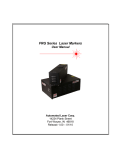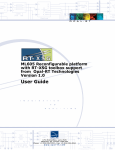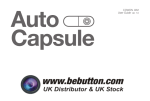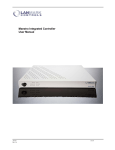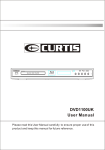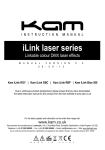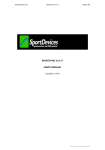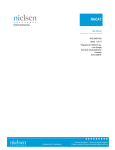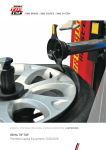Download CSG Series User Manual - Automated Laser Corporation
Transcript
Automated Laser Corporation CSG Series Laser Markers User Guide CSG Series Laser Markers User Manual Automated Laser Corporation 14224 Plank Street Fort Wayne, IN 46818 Release 1.00 – 01/13 1 Automated Laser Corporation CSG Series Laser Markers User Guide Table of Contents FCC Compliance ______________________________________________________________________ 6 System Description _____________________________________________________________________ 7 Unpacking the System __________________________________________________________________ 8 System Connections ____________________________________________________________________ 9 Indicators ___________________________________________________________________________ 10 System Start-Up ______________________________________________________________________ 11 Operation ___________________________________________________________________________ 12 General Overview __________________________________________________________________________ 12 Objects ___________________________________________________________________________________ 13 Marking your job ___________________________________________________________________________ 15 Power Adjustment __________________________________________________________________________ 16 Shutting Down _______________________________________________________________________ 17 Automatic Mode ______________________________________________________________________ 17 Mounting the marker head _____________________________________________________________ 20 Interfacing to Other Systems ____________________________________________________________ 20 Remote Interlock ___________________________________________________________________________ 21 Laser Enable _______________________________________________________________________________ 21 Trigger ___________________________________________________________________________________ 21 Fume Extraction ___________________________________________________________________________ 22 General Maintenance _________________________________________________________________ 23 Cleaning the Air Filters ______________________________________________________________________ 23 Inspecting and Cleaning the Exit Aperture ______________________________________________________ 23 Replacing the fuse __________________________________________________________________________ 23 Additional inspections _______________________________________________________________________ 24 Warranty And Limitation Of Liability_____________________________________________________ 25 Electrical Specifications _______________________________________________________________ 26 I/O _______________________________________________________________________________________ 26 Sample connections _________________________________________________________________________ 27 Mechanical Specifications ______________________________________________________________ 28 Appendix A: Laser Safety ______________________________________________________________ 29 2 Automated Laser Corporation CSG Series Laser Markers User Guide Appendix B: Using the Serial Port to transfer Line Data to the CSG-Series Markers _______________ 31 Description ________________________________________________________________________________ 31 Setup _____________________________________________________________________________________ 31 Communication Port _______________________________________________________________________________ 31 Cabling __________________________________________________________________________________________ 31 3 Automated Laser Corporation CSG Series Laser Markers User Guide REQUIRED PRECAUTIONS 1. This equipment must be operated by Class IV Laser trained and qualified personnel only. Read and understand this manual before operating the equipment. 2. Prior to operating this equipment, safety shielding must be supplied by the end user to enclose the lens aperture and marking area. This shielding should meet the requirements of a Class I enclosure as defined by the Center for Devices and Radiological Health (CDRH). This shielding must be present on the machine, interlocked and activated to protect personnel from contacting direct or scattered invisible laser radiation. DO NOT BYPASS interlocks during operation at any time. Only authorized service personnel are to have access to any bypass interlocks. 3. Always remove all electrical power prior to servicing or adjusting the system. Do not remove the housing or aperture shield at any time. Any internal service to the CSG-10 marking heads must be completed by factory trained or certified personnel only to avoid injury and to maintain the factory warranty. All service internal to the marker head is to be performed by the factory. 4. This equipment is designed to cycle automatically when activated. Always keep hands, loose clothing, hair, etc. away from the lens aperture and all moving parts of the equipment during the operation of the machine. 5. The laser beam exits the laser housing bottom aperture opening. Never look into or expose skin to the beam area at any time with power applied to the system. Always remove AC power to the complete system before service or adjustment. 6. As with any machine, bodily harm may result from misuse, lack of training, maintenance or experience with the equipment, etc. Always observe safety precautions both as stated within these guidelines as well as standard operational considerations for any Class IV Laser equipment and/or automated machinery. 7. Use caution if operating the system with flammable materials. Some materials may burn or ignite when exposed to laser radiation. Venting of the material vapors that result from laser etching is recommended in all applications and especially in those applications where burning of the intended materials produced any byproducts known to be a health hazard. See Section 7.3 in the ANSI Z136.1-1993 Standard for the Safe Use of Lasers, for exposure criteria in 29 CFR 1910 Subpart Z (from the US Government). Also, see the American Conference of Governmental Industrial Hygienists (ACGIH) for published Threshold Limit Values (TLVs). It may also be necessary to consult with your local government agencies regarding restrictions on the venting of vapors. 8. This product emits invisible laser radiation. Do not allow any part of your body (including skin, hair, eyes, etc.) to come into contact with the radiation emitted from this product, whether direct or scattered. Protective eyewear must be worn when operating and servicing this unit. 4 Automated Laser Corporation CSG Series Laser Markers User Guide Note: The information presented within this document is provided as a guide to the operation and function of this equipment as well as related safety warnings and precautions. Although every effort was made to provide this documentation as complete, the possibility exists that some portion of information may not be included within this manual. Only those trained, qualified and familiar with the operation and servicing of Class IV automated laser equipment should operate this system. Should any questions exist regarding the safe operation of this equipment, contact Automated Laser Corp., Fort Wayne, IN prior to operation or service. For additional related Class IV laser guidelines and regulations, see ANSI Z136.1-1993 Standard for Safe Use of Lasers, or contact the Center for Devices and Radiological Health, Div. Of FDA, 2098 Gaither Road, Rockville, Maryland 20850. 5 Automated Laser Corporation CSG Series Laser Markers User Guide GENERAL SAFETY • Read and understand this manual completely before operating this machine. The machine can cycle automatically and must be operated by qualified personnel only. • This equipment is supplied as a Class IV Laser Product. All applications must consider use and operator safety requirements at all times. Industry standards are set as outlined in ANSI standard Z136.1, CDRH regulations and as published by ANSI/OSHA requirements. • See Appendix B included with this manual for additional safety information. • Note all warning signs and labels attached to the equipment. Caution: Use of controls, adjustments, or performance of procedures other than those specified herein may result in hazardous radiation exposure. FCC COMPLIANCE This equipment has been tested and found to comply with the limits for a Class A digital device, pursuant to Part 15 of the FCC Rules. These limits are designed to provide reasonable protection against harmful interference when the equipment is operated in a commercial environment. This equipment generates, uses, and can radiate radio frequency energy and, if not installed in and used in accordance with this instruction manual, may cause harmful interference to radio communications. Operation of this equipment in a residential area is likely to cause harmful interference in which case the user will be required to correct the interference at his own expense. Note: Any changes or modifications made to this piece of equipment not expressly approved by Automated Laser Corp. could void the user’s authority to operate the equipment. 6 Automated Laser Corporation CSG Series Laser Markers User Guide CSG Series Laser Marker Description SYSTEM DESCRIPTION The CSG Series Laser Marker is a high-speed industrial permanent marking system. The system comes complete with everything needed to run, including the marker head, controller, and software. (Note: Optional Monitor, keyboard, and mouse may be purchased from Automated Laser or provided by the end-user). A detailed description of each component follows: Marker Head The marker head contains the beam delivery optics and the laser, which is a sealed, industrial Carbon Dioxide Laser unit. Also contained in the Control housing are the supporting electronics and controller. The CSG-10 series marker head provides a 4” X 4” marking window at a maximum of 10 watts of optical power. Other marking window sizes and laser power options are available upon request. Controller The control system is enclosed inside the control housing and performs all of the necessary system control. WinLASE LAN Software The WinLase LAN Software comes installed on the system controller. This software provides the functionality for all of the marking parameters. Cables The CSG-10 requires a standard molded AC power cable. Depending on the desired level of automation, an I/O cable may need to be constructed by the user. This cable attaches to the marker head and provides supplemental I/O, including trigger, safety interlocks, and a Mark In Progress output. This would be connected to the pluggable screw-terminal block on the back of the marker head. If a host computer will be used to send the CSG-10 marking information, then a standard RS-232C Serial cable will be required. See Appendix B for details. 7 Automated Laser Corporation CSG Series Laser Markers User Guide UNPACKING THE SYSTEM The CSG series markers are carefully packaged prior to shipment. Be sure to save the cartons and packing material in case you need to ship the system. Note: If your CSG Series marker needs to be returned to the factory for any reason, the warranty will be voided if the system is not returned to Automated Laser Corporation in its original packaging. An approved shipping container can be ordered by contacting Automated Laser Corporation. Marking System Open the shipping container and remove the packing material. Lift the marker head and control housing out of the container and place on a bench. Accessories Included in the shipping carton should be accessories, such as this manual, a power cable, I/O connector, and a USB security dongle. Once all of the components are unpacked, place them on a bench. You are now ready to make the system connections. 8 Automated Laser Corporation CSG Series Laser Markers User Guide SYSTEM CONNECTIONS Automated Laser, Inc. recommends using a multiple outlet strip with surge protection to supply power to the marking system. This will not only protect the system from power surges, but will be a convenient way of turning the system on and off. Interface The monitor is a standard 15-pin SVGA cable that plugs into the back of the laser controller. Plug in a USB keyboard and mouse on the back of the laser controller. Power Cable After verifying that the power switch is in the OFF position, plug in the molded 120-VAC power cord into the laser controller, and monitor. Finally plug the other ends of all the power cables into the outlet strip. Interlocks The CSG Series marking heads have a series of interlocks to provide an advanced level of safety while operating the unit. Whenever an interlock is opened, the power to the internal laser is removed and/or the safety shutter is closed. Key Switch The key switch on the back panel of the marker head closes the laser safety shutter. While the key is in the ON position, it cannot be removed. Remote Interlock The remote interlock connection controls the laser safety shutter and must be tied together for operation of the laser. These can be found on Pins 9 and 10 of the User I/O connector on the back panel of the control housing. These positions are shipped from the factory with a jumper installed. This is intended to be used with external safety equipment, PLCs, and lockout devices. Other Interlocks There is an additional Laser Enable interlock on pins 7 and 8 of the User I/O connector that may be used to momentarily defeat the laser output. This interlock is intended to be used on a piece of guarding that has to opened to allow a part to be changed as on a piece of automated equipment. While this interlock is open, the laser output is defeated by an internal mechanical shutter being placed in the beam path. Once these contacts are closed again, laser output is restored after 5 seconds. 9 Automated Laser Corporation CSG Series Laser Markers User Guide INDICATORS The CSG laser marker has an LED indicator to monitor status of the system. Mark in Progress The Mark in Progress (MIP) LED is located on the Front of the laser marking head and illuminates any time there is laser output in progress. 10 Automated Laser Corporation CSG Series Laser Markers User Guide SYSTEM START-UP Caution: Use of controls, adjustments, or performance of procedures other than those specified herein may result in hazardous radiation exposure. • Once all of the connections are made, switch on the Marker Head and Monitor. • If you are using a multiple outlet strip, switch it ON to apply power to the system. The computer will perform its boot tasks and start the WinLase LAN Software, showing the main screen. Figure 1: WinLase LAN Software Main Screen 11 Automated Laser Corporation CSG Series Laser Markers User Guide OPERATION General Overview Figure 2: WinLase LAN Screen The opening screen of the marking software with the default job opened will look very similar to the screen shown in Figure 2. The large window in the center of the screen represents the marking field of the laser. Objects to be marked can be placed in this window and will mark in the same relative location in the actual marking field of the laser. The section to the upper left shows the active laser connections and open jobs. The section in the lower left shows the Objects associated with a complete marking profile. These objects are processed from top to bottom each time a mark is started. The section on the right side can be used to store and access different marking profiles. The following section describes the function of each of the automation objects used in the standard marking profile. 12 Automated Laser Corporation CSG Series Laser Markers User Guide Objects Figure 3: Objects Objects may be added by selecting Objects > Add >Automation from the menu bar, or by clicking their corresponding icon on the far left of the window. Objects control the flow of the marking profile and process from top to bottom when the mark job is started. In the example shown above, once the job is started, the laser will mark the first rectangle, then the second, a polygon (circle), a True Text object, a rectangle, a Simple Text object and finally another circle – in that order. Clicking on any of these objects then pressing F2 will open that object’s properties window where the parameters for that object may be modified. Object Properties Figure 7: Text Parameters The object properties define the speed and power for the object to be marked. Each object may have different power and speed settings. This is particularly useful when marking text and graphics together. Each may be independently controlled to provide the best mark quality. 13 Automated Laser Corporation CSG Series Laser Markers User Guide Other parameters in the lower section of this window may be used to fine tune how characters are drawn. The default settings are generally adequate for most marking needs, but the WinLase LAN software gives us the flexibility to further tweak the marks for special needs. 14 Automated Laser Corporation CSG Series Laser Markers User Guide Marking your job To begin marking, simply click on the green ‘Run Process’ icon located on the top toolbar, or press F12. This will start the job marking by working down the list of Objects. Depending on how the software is configured, it may be necessary to click on this icon each time you want to mark. Typically in an automated system the software would be configured to receive this Run command serially to enable the job each cycle, or by an external trigger (dry contact closure) connected to pins 1 and 2 of the rear I/O connector. 15 Automated Laser Corporation CSG Series Laser Markers User Guide Power Adjustment The laser output power is adjusted via the marking object’s properties window. Each object may have its own power level setting, allowing ultimate flexibility in marking clarity between objects. Because of the wide range of materials capable of utilizing laser marking, experimentation will be needed to determine the optimum laser power and beam velocity settings. In some cases poor marking output may be attributed to incorrect power or speed settings. If assistance is required in determining the best range for these settings, please contact the factory. NOTE: Automated Laser strongly recommends leaving the Key Switch on the control enclosure in the OFF position until you are ready to mark. Once marking is completed, turn the switch to the OFF position. NOTE: In order for the Laser Marker to work, all interlocks must be closed. This means that the Key Switch on the control enclosure must be ON, and the Remote Interlock as well as the Laser Enable terminals on the User IO connector must have their circuits closed. 16 Automated Laser Corporation CSG Series Laser Markers User Guide SHUTTING DOWN • Wait for any active job to complete marking. • Close the WinLase LAN software, saving any changes you have made when prompted. • Exit Windows • Switch off laser power. AUTOMATIC MODE The CSG Series markers can be run in an Automatic mode where the system goes to the Marking Screen, waiting for a trigger upon startup. To have the system start in automatic mode, there must be a job selected in the System Preferences dialog box. Fig. 9 System Preferences Select ‘Load a Specific Job’ from the drop down list and Browse to the job file you want to have started automatically This will load the selected job, but will not enable the job for marking. To do this you will need to either select the green ‘Run Process’ icon from the menu bar, enable the external start from the job settings dialog box or enable the job via serial commands in Host mode. 17 Automated Laser Corporation CSG Series Laser Markers User Guide The settings for External Start should be the following: Fig. 10 External Start Settings ‘Wait for an external signal’ should be selected. the I/O port should be ‘Start mark on laser system’ and the trigger mode should be ‘After transition from Low -> High’. Host mode starts the laser in a “listening” mode with no job active. The following describes how to enable Host mode, and the commands are used to load a job and enable it for marking. 18 Automated Laser Corporation CSG Series Laser Markers User Guide Select System -> Preferences from the menu bar. In the Host Interface tab, select the host connection type, port, and speed parameters and check the ‘Enter Run from Host mode’ box to enable the program to receive serial data on startup. Fig. 10 In Host mode the following commands may be sent to the laser to initialize a job file. WinLase LAN serial commands Command OPEN,file,C:\Default.wmj MODIFY,field,04,***** RUN After marking…. MODIFY,field,04,***** RUN Action Loads the specified job for marking. Full path with extension is required. Inserts the data "****" to be marked into our field. Laser is now waiting for trigger input. Inserts new data "****" to be marked into our field. (Optional) Laser is now waiting for trigger input. At end of run…. SET,control,local Returns control of program to the keyboard so user can access menu options or shut down the marker. 19 Automated Laser Corporation CSG Series Laser Markers User Guide MOUNTING THE MARKER HEAD The CSG Series marker heads are designed with a focal length of approximately 6 inches from the baseplate of the laser. This distance is critical for high-quality laser marking. Failure to position the marking part within tolerance will cause blurring of the mark or even eliminate marks at any power or speed setting. The marker head may be mounted utilizing the five ¼-20 threaded holes on the bottom of the unit. To minimize the effects of vibration, mount the marker head to solid surface. This will prevent the mechanical motion of the marker from agitating the work piece. INTERFACING TO OTHER SYSTEMS Several features of the CSG Series Markers make it easy to interface to external control systems. As stated in the Triggers Section, a trigger may be assigned to a function key or a programmable input. All of the external I/O connections can be found on the pluggable screw-terminal connector on the back of the marker head. Pin 1 2 3 4 5 6 7 8 9 10 Description + 5VDC Return + 5VDC Out N/C N/C MIP MIP + Laser Enable + Laser Enable Interlock Interlock + Comment Dry Contact closure to start marking Not Connected Contact Closure when the laser is marking a job Short to enable laser. Defeats the laser enable signal. Short to enable laser. Defeats the laser shutter. 20 Automated Laser Corporation CSG Series Laser Markers User Guide Remote Interlock The Remote Interlock can be found on Pins 9 and 10 of the User I/O connector. This is a safety device that is normally wired through a safety circuit such as an Emergency Stop. These two terminals need to be connected together in order for the laser to work. Dry contacts are recommended for this input. This is intended to provide a means of safety without the 5 second re-energizing requirement of the laser enable interlock. Laser Enable The Laser Enable input allows the user to disable the command signal to the laser. Trigger The Trigger Input is activating by shorting pins 1 and 2 on the I/O connector together. Dry contact PLC outputs, or a relay contact are recommended for these inputs. 21 Automated Laser Corporation CSG Series Laser Markers User Guide NOTES ABOUT M ARKING Fume Extraction Due to the variety of materials that the CSG Series Markers can mark, Automated Laser strongly recommends that you provide a method of fume extraction around the marker head. The reason for this is two-fold: 1. Different materials respond differently to laser marking. Most materials release an unpleasant odor when marked, possibly causing operator discomfort. Some of these odors may be not only unpleasant, but hazardous to breathe for extended periods of time. Certain materials can produce noxious, toxic, or even fatal contaminants in the air when processed with a laser. The vapors, fumes, and/or particles that result from laser marking should be thoroughly evaluated, and the adequacy of the provisions for fume extraction, filtering, and venting should be carefully considered. See Section 7.3 in the ANSI Z136.1-1993 Standard for the Safe Use of Lasers, for exposure criteria in 29 CFR 1910 Subpart Z (from the US Government). Also, see the American Conference of Governmental Industrial Hygienists (ACGIH) for published Threshold Limit Values (TLVs). It may also be necessary to consult with your local government agencies regarding restrictions on the venting of vapors. 2. While every attempt has been made to provide a virtually maintenance-free system, the release of by-products in the air while marking can accumulate on the exit aperture. This is a very delicate lens that focuses the beam to a very small point. If a means of fume extraction is not provided, this lens will need to be cleaned regularly. Because the CSG Markers are real-time marking systems and need to perform real-time calculations on the fly, the WinLASE LAN Software demands dedication of the computer’s processor to the marking task. Installing additional applications, utilities, and networking can cause unpredictable results with the laser marker. It is best to consider the CSG computer as a dedicated controller, to be used only for laser marking. 22 Automated Laser Corporation CSG Series Laser Markers User Guide GENERAL MAINTENANCE Cleaning the Air Filters If the marker system is heavily used, the air filters should be cleaned on a weekly interval. Remove power from the Marking System. 1. Snap the filter guard off of the fan housings. 2. Remove the foam filter. Wash clean using warm water. A very mild, diluted detergent may be used. 3. Allow filter to dry completely before re-installing. The filter may be cleaned less frequently if the marking system is used under a lighter duty. Inspecting and Cleaning the Exit Aperture The exit aperture is the final optic that the beam passes through prior to marking. This can be found on the bottom side of the laser marker. The lens should appear clean, free of dust and fingerprints. If this is not the case, perform the following steps for cleaning: 1. Remove all power from the marking system. 2. Turn off the key switch and remove the key. 3. Remove light dust and debris with an air duster. 4. Using rubbing alcohol and a cotton swab, clean the lens using very light pressure in a circular motion. Do not use excessive force. The lens is easily scratched and can be damaged from trying to clean it. 5. Allow to air-dry. The accumulation of dirt on the exit aperture can cause the lens to over-heat and break. A dirty lens will also reduce the net output power of the laser. Replacing the fuse A 7-Amp fuse protects the AC input to the marker head (CSG-10). If the cooling fans do not turn when power is applied, the input fuse may need replacing. 1. Remove the power cord from the input module. 2. Using a small screwdriver, open the hinged cover to the power entry module. 3. Lift up on the red insert with the screwdriver. Note the orientation of the text “115V” on the red insert. 4. Remove the fuse from the insert. Check for continuity to make sure it is blown. 5. If blown, replace with an equivalent 7A ¼” X 1-¼” fuse. Use Buss number AGC-7 or equivalent. 23 Automated Laser Corporation CSG Series Laser Markers User Guide 6. Replace the fuse into the insert. 7. Replace the insert into the input module, noting the correct orientation. 8. Snap the hinged cover closed on the input module. NOTE: Be certain that the “115 V” text is displayed in the window on the input module. If not, reverse the red insert. Additional inspections 1. Ensure that the “LASER ON” Indicator properly functions during marking. Perform a test mark. The indicator should turn on after activating the marking trigger and turn off once the mark is complete. 2. Inspect the housing, making sure there are no gaps or holes that could allow laser energy to exit the marking head assembly. Caution: There is no need to remove the marker housing for standard maintenance procedures. Laser radiation levels inside the housing can be as high as 30 W. 24 Automated Laser Corporation CSG Series Laser Markers User Guide WARRANTY AND LIMITATION OF LIABILITY Automated Laser Corporation, Fort Wayne, IN warrants to the original end user purchaser (the “purchaser”) of the equipment supplied by Automated Laser Corporation (“equipment”) that such equipment will be free from manufacturing defects in materials and workmanship use for a period of one year from the date of shipment to the purchaser from the factory or authorized distributor. This warranty only applies if the product is received by the purchaser as new, in the original factory sealed shipping carton and is used under normal service and for the intended equipment purpose. Automated Laser Corporation’s obligation under this warranty shall be strictly and exclusively limited to the repairing or replacing any such equipment that is found to be defective in material or workmanship under normal use and service provided the equipment is returned to the factory within one (1) year from the date of the original shipment to the purchaser. This warranty does not apply to any product that has been tampered with, altered or modified in any way or improperly installed, misused or damaged. THIS STATED WARRANTY IS IN LIEU OF ANY OTHER WARRANTIES, EXPRESS OR IMPLIED, INCLUDING, WITHOUT LIMITATION, ANY IMPLIED WARRANTY OF MERCHANTABILITY OR FITNESS FOR A PARTICULAR PURPOSE, AND OF ANY OTHER OBLIGATIONS OR LIABILITIES ON THE PART OF AUTOMATED LASER CORPORATION. IN ADDITION, NO OTHER PERSON OR ORGANIZATION IS AUTHORIZED TO ASSUME OR EXTEND FOR AUTOMATED LASER CORPORATION ANY OTHER LIABILITY WITH RESPECT TO EQUIPMENT MANUFACTURED OR SUPPLIED BY AUTOMATED LASER CORPORATION. AUTOMATED LASER CORPORATION SHALL HAVE NO LIABILITY WHATSOEVER IN ANY EVENT FOR PAYMENT OF ANY INCIDENTAL OR CONSEQUENTIAL DAMAGES INCLUDING, WITHOUT LIMITATION, DAMAGES FOR INJURY TO ANY PERSON OR PROPERTY, OR LOSS OF SERVICE OR PRODUCTION, AND COSTS INLUDING ATTORNEY FEES. Equipment subject to this stated warranty must be authorized by the factory to be returned for evaluation, repair or replacement prior to shipment from the purchaser to Automated Laser Corporation complete and returned complete in the original shipping packaging. Unless pre-approved in writing, Automated Laser Corporation shall not be responsible for any freight or transportation charges incurred for any shipments. IN NO EVENT WILL AUTOMATED LASER CORPORATION BE LIABLE FOR ANY DAMAGES (INCLUDING ATTORNY’S FEES) ARISING OUT OF THE SALE OF EQUIPMENT, SOFTWARE, PROGRAMMING OR ANY SERVICES, INCLUDING LOSS OF USE OF EQUIPMENT, LOSS OF PROFIT, LOSS OF DATA, INCINDENTAL, CONSEQUENTIAL OR INDIRECT DAMAGES OR ANY OTHER LOSSES, WHETHER SUCH LIABILITY IS BASED ON WARRANTY, NEGLIGENCE, CONTRACT, STRICT LIABILITY IN TORT OR OTHERWISE. THE PURCHASER REMAINS RESPONSIBLE TO APPROVE THE OPERATION, SAFETY AND ACCURACY OF RESULTS FOR ALL APPLICATIONS AND ACKNOWLEDGES THIS RISK AS AN AGREEMENT OF PURCHASE. 25 Automated Laser Corporation CSG Series Laser Markers User Guide ELECTRICAL SPECIFICATIONS Component Marker head Laser module Electrical Specification Voltage Current Frequency 115 vac 7 amps 60 hz Laser power output Laser Wavelength 10 watts 10.57 um to 10.63 um I/O Output MIP User I/O pins 5-6 CSG-10 +5VDC Comments Input Trigger Laser Enable 1-2 Dry contact closure 7-8 Interlock 9 - 10 Dry contact closure Typically through MCR or Safety relay. 26 Automated Laser Corporation CSG Series Laser Markers User Guide Sample connections The following diagram is a representation of a typical interface. This is not intended to be allinclusive. Figure 11: Typical User Connections 27 Automated Laser Corporation CSG Series Laser Markers User Guide MECHANICAL SPECIFICATIONS Marker Head CSG-10 Controller A B C 17.5” 3.5” 19” Remote Head A B C 28” 8.1” 6.12” Figure 12: Housing Dimensions 28 Automated Laser Corporation CSG Series Laser Markers User Guide APPENDIX A: LASER SAFETY Safety Standards The most predominating set of standards for laser safety can be found in the American National Standards Institute’s (ANSI) publication Z136.1 – Standard for the Safe Use of Lasers. This document is referenced by Federal and state authorities, as well as OSHA, and can be obtained from ANSI or the Laser Institute of America (LIA), at 407-380-1553. Additionally, your state may have regulations for laser safety. The type of laser in the CSG Series Marking Head is a CO2 Class 4 system. A Class 4 laser or laser system is any that exceeds the output limits (Accessible Emission Limits, AEL's) of a Class 3 device and are considered to be an acute hazard to the skin and eyes from scattered or direct radiation. As would be expected, these lasers may be either a fire or skin hazard or a diffuse reflection hazard. Very stringent control measures are required for a Class 4 laser or laser system. The end use applications must take standard industry precautions into account for the safe use of this product. Laser Beam Hazards The CSG Series Laser Marker produces an intense beam of coherent (same wavelength) light. This light is in the mid-infrared region and is not visible by the human eye. By nature, when light falls upon an object, it will be partially absorbed by that object. This is especially true with laser light, which when directed upon an object (whether directly or indirectly) will be at least partially absorbed. When an object absorbs energy such as an intense beam of light, the temperature is raised of the object, which is how the laser performs its function. The laser focuses an intense beam of coherent light onto a very small surface area, causing such results as melting, burning, or deformation. This same intense coherent light when exposed to the human body can result in tissue damage, with the eye being the most vulnerable part of the body. The CSG Series Markers emit a wavelength between 10.57 um and 10.63 um. The part of the eye that absorbs most of this wavelength is the cornea. This is why it is important to wear CO2 certified protective laser eyewear at all times when using the CSG Series Laser Markers. Protective eyewear must be worn when the emitted beam is not completely enclosed with an external housing to create a Class I Enclosure. The skin is also vulnerable to CO2 radiation. Care must be taken to prevent skin exposure to the laser beam, whether direct or scattered. This is why it is important to enclose the beam path whenever possible. 29 Automated Laser Corporation CSG Series Laser Markers User Guide Additional Hazards There are also hazards related to the use of lasers that are not associated directly with the beam. These non-beam hazards include electrocution, fire, and asphyxiation – all of which can result in severe injury or death. Electrocution: If the system needs to be serviced, disconnect all AC power prior to opening the cover. Lethal voltages exist inside the Laser Marker housing, and the cover must not be removed unless absolutely required and with power off. Fire: Due to the wide range of products that can be marked with the CO2 laser, use extreme caution when marking on new materials. The ablation process with a high-energy beam can result in an unintended fire. Asphyxiation: Because the CSG Series Laser Markers typically ablate the material being marked, the resulting smoke and fumes could be a hazard and ventilation is often necessary. Know and understand the materials being processed prior to use. The Laser Safety Officer The ANSI Z136.1 standard specifies that a Laser Safety Officer (LSO) be designated to oversee safety for all operational, maintenance, and servicing situations for any facility using Class 3b or Class 4 lasers or laser systems. The LSO should monitor and enforce the control of laser hazards. This person is also responsible for the evaluation of laser hazards, the establishment of appropriate control measures, training personnel on laser safety, maintenance procedures and schedules, and procurement of laser safety equipment. See ANSI Z136.1 for more information regarding the LSO. For additional related Class IV laser guidelines and regulations contact the Center for Devices and Radiological Health, Div. Of FDA, 2098 Gaither Road, Rockville, Maryland 20850. 30 Automated Laser Corporation CSG Series Laser Markers User Guide APPENDIX B: USING THE SERIAL PORT TO TRANSFER LINE DATA TO THE CSG-SERIES MARKERS Description The CSG Series markers have the capability to retrieve the marking text through the serial port on the controller. This can allow real-time data to be marked, which can come from a variety of sources such as PLCs, other PCs, test equipment, and other processors. Setup Communication Port The primary COM port on the CSG Marker is via a USB to serial adapter (not included). The host controller will need to be configured with the same settings as the CSG Controller, shown below: Baud Rate Parity Data bits Stop bits Soft Handshaking Hard Handshaking 9600 None 8 1 XOn / XOff (off) The XOn/XOff handshaking protocol prevents the COM port from being overrun. A maximum buffer size has been set to 1024 bytes (1 byte is approximately 1 character). When the CSG serial buffer has reached this limit, the XOff character will be sent to the host computer, informing the host to suspend data transfer until an XOn character is sent by the CSG Controller. Once the Marker’s serial buffer has begun to be emptied, the XOn character will be sent to the host, allowing additional data to be sent. If your host controller does not support the XOn/XOff protocol, special care must be taken in order not to overrun the CSG buffer of 1024 bytes. The buffer is cleared every time a valid trigger is received. Cabling Three signals are needed to support data transfers from a host to the CSG Marker. These are the Transmit (Tx), Receive (Rx), and Ground (Gnd). The pin-outs can be found on the 9-pin connector by the diagram below. Receive Transmit Gnd Figure 3: 9-Pin D-Sub Male Serial Connector In order for RS-232 communications to work properly, these minimum signals need to be connected properly. The Receive of one port needs to connect to the Transmit of the other. Similarly, the Transmit of one port needs to connect to the Receive of the other. Finally, the Ground pins from each port must be connected. 31 Automated Laser Corporation CSG Series Laser Markers User Guide The connection method to the host can vary depending on the type of host system. Several options are shown below. Figure 4: Custom Cable Connections from a 9-Pin D-Sub to a 9-Pin D-Sub Figure 14: Connecting a 9-Pin D-Sub to a 9-Pin D-Sub using standard cable assemblies 32
































